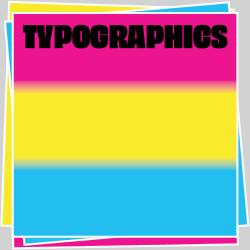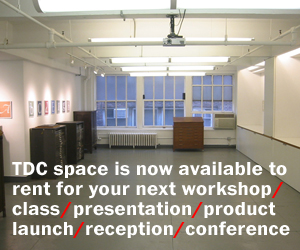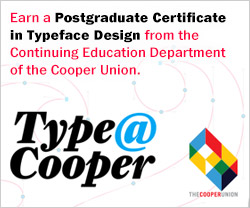Paul Rand Exhibition Tour
This spring, the Museum of the City of New York opened an exhibition of the work of Paul Rand. The Type Directors Club had a long relationship with Paul Rand and is proud to sponsor a guided tour of the exhibition on Friday, May 8. The tour is part of The One Club’s Creative Week festival in New York City. Learn more about the tour and register here.
Since it is significant and unusual for a single graphic designer to have an exhibition of this scale in an American museum, it is a good time to revisit Rand’s ideas about type, and his interactions with the Type Directors Club over many years.
In 1984, The TDC awarded Rand its highest honor, the TDC Medal. He was an obvious choice, famous as an art director and designer since his twenties, creator of corporate logos, and a writer and eminent teacher. His tart manner and fierce, quotable opinions were well known. For instance, Jessica Helfand, a former student of Rand’s, reports that Rand said of type: “the development of new typefaces is a barometer of the stupidity of our profession.” The quote is a bit of a shock, a reminder that Rand could be unrestrained in criticism of his own profession. And how did the TDC, an organization that celebrates and nurtures contemporary type design, both honor Rand and apparently disagree with some of his ideas?

Coronet Brandy magazine advertisement, 1948. An example of Rand’s early advertising work.
The obvious answer is that the TDC was and is a club for all those passionate about type, whether they are five-typefaces-are-enough Modernists or post-everything Ornamentalists. Typefaces continue to be designed, and the TDC continues to provide a forum for their evaluation and criticism.
Also, we cannot judge Rand’s views on type by only one quote. His work and writing reveal practicality and playfulness, and he collaborated with the TDC on design projects and conferences. For instance, he designed a well-known cover of a TDC publication, A 24-Page Book, in 1987. Much earlier, in 1959, he took part in a TDC conference in New York City on the subject of American identity in typography. Rand contributed an essay to the conference publication, Typography—U.S.A., in which he reminded readers of the debt of American designers to European art movements. “I believe,” he wrote, “the ‘New American Typography’ can more accurately be called the New Americanized European Typography since there can be little doubt as to its origin.” Rand was very curious about European art history and its influence on graphic design.

A 24-Page Book, 1987. Cover design by Paul Rand for the TDC.

Jazzways magazine cover, 1946.
Interestingly, designer William Golden (famous for his work for CBS) contributed an essay to the same publication, and the strength of his opinions vied with Rand’s. In his essay, Golden took aim at Rand’s self-regard. Rand was known for signing his work, even small ads. Golden claimed that when designers sign their work they are advertising themselves rather than meeting client needs, and that signatures are possible only when clients have nothing to say. Golden also urged graphic designers to be modest, that they acknowledge that graphic design is a craft requiring humility.
Rand was a Modernist, critical of contemporary design in his later writing, especially his 1993 book Design, Form, and Chaos. He was cranky, well-connected, and associated with large, rich corporations, so, in the 1980s and 90s, he was a conspicuous paternal figure for young designers to rebel against. However, in a 1988 interview with Steven Heller, Rand said of type, “Good typography, whether old or new, doesn’t make a hell of a lot of difference. I respect people who can do traditional typography in a way more than I can some people who do so-called ‘modern’ typography. It has to do with the spacing, it has to do with the layout, it has to do with contrasts. But if you’re looking for a catchword, appropriateness is an important word.”

IBM corporate campus, featuring Rand’s logo. Courtesy of IBM Corporate Archives.
The quote’s opening sentence is a jab at precious typography. However, the following sentences reveal Rand’s lifelong emphasis on the function of design over mindless ideology, a stance that doesn’t exactly soften his reputation, but provides a more balanced view of a complex character. If he was critical, it wasn’t personal; it was all about design.
Take a look at Rand’s work for yourself, in the TDC guided tour of the exhibition Everything is Design: The Work of Paul Rand at the Museum of the City of New York, curated by Donald Albrecht.
—Doug Clouse





